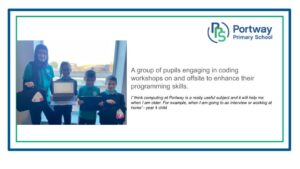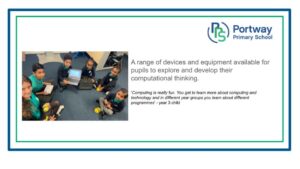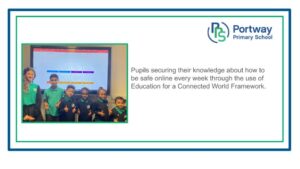Computing
At Portway, we follow the National Curriculum for Computing, delivering a high-quality computing education to create active participants in a digital world. Informed by developments in ICT and best practice nationally, we teach pupils to use their computational and creative thinking to solve problems; to use ICT to communicate effectively and to become digitally literate, preparing them for their future place in the twenty-first-century workplace.
Our Computing Curriculum develops the essential characteristics of coders and users of technology:
- Competence in coding for a variety of practical and inventive purposes, including the application of ideas within other subjects.
- The ability to connect with others safely and respectfully, understanding the need to act within the law and with moral and ethical integrity.
- An understanding of the connected nature of devices.
- The ability to communicate ideas well by using applications and devices throughout the curriculum.
- The ability to collect, organise and manipulate data effectively
Our computing unit coverage provides detailed information as to how we teach all elements of the curriculum across all year groups at our school.
How is computing taught at Portway?
The Computing curriculum is designed to help pupils form a Computing mental model within their long-term memories.
Schema theory states that all knowledge is organised into units. A mental model is, therefore, a conceptual system for understanding knowledge.
Our Computing Mental model is a way of organising Computing substantive and disciplinary knowledge in a meaningful way; it is an appreciation of how facts are connected and the ways in which they are connected. It is distinct from information, which is just isolated facts that have no organisational basis or links.
Big Ideas help form the basis of the mental model. Big Ideas are key concepts that underpin the subject. There are three Big Ideas in Computing:
- Information Technology – This concept involves using and combining software from a range of devices to create programs, systems and a range of content.
- Digital Literacy – This concept involves an understanding of how to use information and communication technology to express themselves safely and respectfully, becoming active participants in a global digital world.
- Working technically – This concept involves learning the principles of information and computation, how digital systems work, and how to put this knowledge to use through programming.
Each Big Idea has knowledge strands which help to strengthen the mental model. Learning knowledge in each of the strands allows pupils to express and demonstrate their understanding of the Big Idea, which gradually develops as pupils return to them over and over again.
What makes computing at Portway unique?




